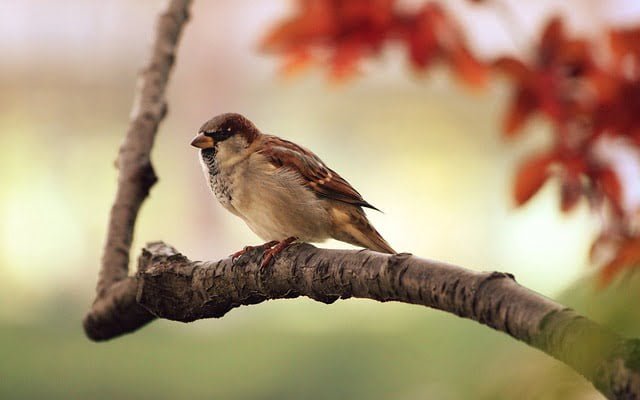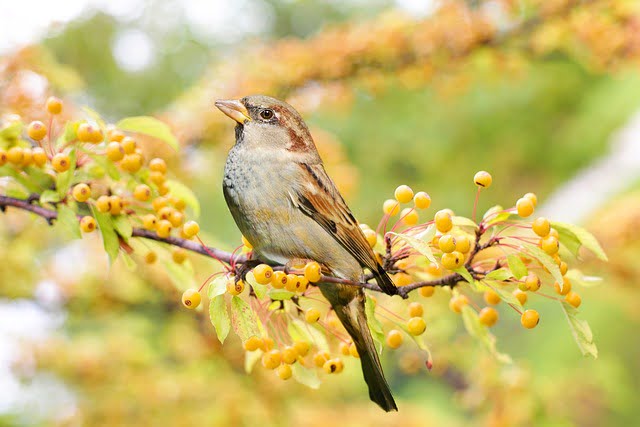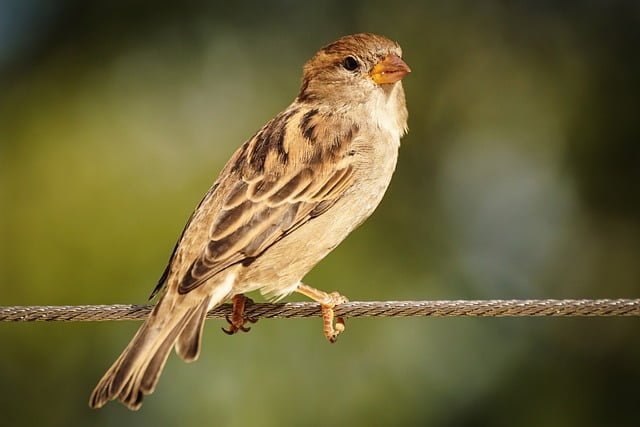Sparrows are a common sight in many parts of the world, with their distinctive chirping and small size. But have you ever wondered how long these little birds live? The lifespan of sparrows can vary depending on the species and their environment, and it’s an interesting topic to explore.
According to our research, the average lifespan of house sparrows, one of the most common species, is around 3 years. However, there are other types of sparrows that can live longer, with some reaching up to 13 years in captivity. Factors such as their habitat, predators, and disease can all play a role in their lifespan.
Understanding the lifespan of sparrows can help us better appreciate these birds and the role they play in our ecosystem. In this article, we’ll take a closer look at the different factors that influence the lifespan of sparrows and explore some of the most interesting findings about these fascinating creatures.

Table of Contents
Sparrow Lifespan in the Wild
Sparrows are small, cute birds that are found all over the world. They are known for their distinctive chirping sounds and their social nature. But how long do sparrows live in the wild?
Factors Affecting Lifespan
The lifespan of sparrows in the wild is affected by several factors. These include:
- Predators: Sparrows are preyed upon by a variety of animals, including cats, snakes, and birds of prey. This can significantly reduce their lifespan.
- Diseases: Sparrows are susceptible to a wide range of diseases, including avian flu, West Nile virus, and salmonella. These diseases can be fatal and can quickly spread within a flock.
- Environment: Sparrows are adapted to living in a wide range of environments, from forests to deserts. However, changes to their environment, such as habitat loss or pollution, can negatively impact their lifespan.
- Human activity: Human activity, such as hunting, trapping, and habitat destruction, can also reduce the lifespan of sparrows.
Survival Rate
Despite these challenges, sparrows are resilient birds and have adapted to survive in many different conditions. In the wild, sparrows typically live for 3 to 5 years, but some species can live up to 13 years or more.
The survival rate of sparrows varies depending on the species and the location. For example, house sparrows are one of the most common sparrows in North America and have a relatively high survival rate. On the other hand, some species of sparrows that live in more extreme environments, such as the desert sparrow, have a lower survival rate.
In conclusion, the lifespan of sparrows in the wild is affected by a variety of factors, including predators, diseases, environment, and human activity. Despite these challenges, sparrows are adaptable birds that have a relatively high survival rate.
Sparrow Lifespan in Captivity
Sparrows are small, hardy birds that can adapt to various environments, including captivity. In captivity, sparrows have been known to live longer than those in the wild. In this section, we will explore the lifespan of sparrows in captivity and the factors that affect it.
Care and Maintenance
The care and maintenance of sparrows in captivity are crucial to their lifespan. As with any pet, it is essential to provide them with a suitable habitat, adequate food, and clean water. Sparrows require a spacious cage that allows them to fly and move around freely. The cage should also have perches and toys to keep them entertained.
Sparrows feed on a variety of seeds, fruits, and insects. It is essential to provide them with a balanced diet that meets their nutritional needs. Fresh water should be provided daily, and the cage should be cleaned regularly to maintain hygiene.
Common Health Issues
Sparrows in captivity are prone to various health issues that can affect their lifespan. Some of the common health issues include:
- Obesity: Sparrows that are overfed or have limited exercise can become obese, which can lead to health problems.
- Respiratory infections: Sparrows are susceptible to respiratory infections, which can be caused by poor ventilation or exposure to cold temperatures.
- Feather plucking: Sparrows may pluck their feathers due to stress or boredom, which can lead to skin infections.
It is essential to monitor the health of sparrows in captivity and seek veterinary care if necessary. Regular check-ups and vaccinations can help prevent health issues and ensure a longer lifespan.
In conclusion, sparrows in captivity can live longer than those in the wild if provided with proper care and maintenance. By providing them with a suitable habitat, balanced diet, and regular veterinary care, we can ensure that they live a healthy and happy life.

Sparrow Species and Their Lifespans
Sparrows belong to the family Passeridae, which includes over 40 species of small, seed-eating birds. The lifespan of a sparrow depends on several factors, including the species, whether it’s in captivity or the wild, and its environment.
Here are some common sparrow species and their average lifespans:
- House Sparrow: The most common sparrow species, house sparrows usually live 3 to 5 years. However, they can live up to 15 years in captivity.
- White-crowned Sparrow: This species has an average lifespan of 5 to 6 years in the wild, but they can live up to 13 years in captivity.
- Song Sparrow: Song sparrows usually live 2 to 3 years in the wild, but they can live up to 10 years in captivity.
- Chipping Sparrow: Chipping sparrows have an average lifespan of 2 to 3 years in the wild, but they can live up to 10 years in captivity.
- Savannah Sparrow: This species has an average lifespan of 2 to 3 years in the wild, but they can live up to 10 years in captivity.
It’s important to note that these are just average lifespans, and individual sparrows can live longer or shorter depending on their environment and other factors.
Overall, sparrows have relatively short lifespans compared to other bird species. However, they are adaptable and resilient birds that can thrive in a variety of habitats, from urban areas to rural farmlands.
Comparative Lifespan Study
Sparrows Vs. Other Birds
When it comes to the lifespan of birds, there is a lot of variation. Some birds live for only a few years, while others can live for decades. In general, sparrows have a relatively short lifespan compared to other bird species. For example, the average lifespan of a sparrow is around three years, while some species of parrots can live for more than 80 years.
However, it’s important to note that there are many factors that can influence the lifespan of a bird. For example, the environment, diet, and genetics can all play a role. Additionally, different species of sparrows can have different lifespans. For example, house sparrows typically live for three to five years, while other species of sparrows can live for up to nine years.
Sparrows Vs. Mammals
When comparing the lifespan of sparrows to that of mammals, it’s important to keep in mind that there is a much greater range of lifespans among mammals than among birds. For example, some species of whales can live for more than 100 years, while mice typically live for only a year or two.
In general, sparrows have a relatively short lifespan compared to most mammals. For example, the average lifespan of a house sparrow is around three to five years, while the average lifespan of a domestic cat is around 15 years. However, there are some mammals that have shorter lifespans than sparrows, such as some species of rodents and shrews.
Overall, while sparrows may not live as long as some other bird or mammal species, they are still an important part of many ecosystems. By understanding the factors that influence their lifespan, we can better protect these fascinating and important birds.
Impact of Human Activities on Sparrow Lifespan
Human activities can have a significant impact on the lifespan of sparrows. Here are some ways in which human activities can affect the lifespan of sparrows:
- Habitat Loss: Sparrows rely on a variety of habitats, including grasslands, shrublands, and wetlands. Human activities such as urbanization and agriculture can lead to the destruction of these habitats, which can reduce the availability of food and shelter for sparrows. This can, in turn, reduce their lifespan.
- Pollution: Human activities such as industrialization and transportation can lead to pollution, which can have a negative impact on the health of sparrows. Air pollution, for example, can lead to respiratory problems, while water pollution can lead to the contamination of food sources. This can make sparrows more susceptible to disease and other health problems, which can reduce their lifespan.
- Predation: Human activities such as the introduction of non-native predators can have a significant impact on the lifespan of sparrows. For example, domestic cats are a major predator of sparrows, and their introduction to new areas can lead to a significant decline in sparrow populations. This can reduce the overall lifespan of sparrows in affected areas.
- Pesticides: Human activities such as the use of pesticides can also have a negative impact on the lifespan of sparrows. Pesticides can contaminate the food sources of sparrows, which can lead to health problems such as weakened immune systems and reproductive problems. This can, in turn, reduce their lifespan.
Overall, human activities can have a significant impact on the lifespan of sparrows. It is important to take steps to minimize these impacts and protect the habitats and health of sparrows to ensure their continued survival.
Conservation Efforts and Their Effects on Sparrow Lifespan
Conservation efforts have been implemented to help increase the lifespan of sparrows. These efforts have been made to help protect the declining populations of sparrows and to help promote their survival.
One of the main conservation efforts that have been put in place is the protection of their habitats. Sparrows require specific habitats to survive, and these habitats are often threatened by human activities such as urbanization and deforestation. By protecting their habitats, we can help ensure that sparrows have a place to live and thrive.
Another conservation effort that has been put in place is the reduction of pesticide use. Pesticides are often used to control insects that can damage crops, but they can also harm sparrows and other birds. By reducing pesticide use, we can help reduce the negative impact on the sparrow population and promote their survival.
In addition to these efforts, there are also programs in place to help monitor the sparrow population. By monitoring the population, we can identify areas where conservation efforts are needed and make adjustments to our conservation efforts accordingly.
Overall, conservation efforts have had a positive impact on the sparrow population. While there is still work to be done, these efforts have helped increase the lifespan of sparrows and promote their survival.

Conclusion
Based on our research, the average lifespan of a sparrow ranges from 1-5 years depending on various factors. Old World sparrows have a lifespan of 3-5 years, while house sparrows have a limited lifespan of 4-5 years on average.
Factors such as toxic substances, environment, weather conditions, and food availability influence sparrow lifespan. Threats to sparrows include window collisions, predators, and sensitivity to toxic substances like pesticides and heavy metals.
It is important to note that while some sparrows may live longer in captivity, it is not recommended to keep them as pets. Sparrows are wild birds and thrive in their natural habitats.
To help increase the lifespan of sparrows, humans can take steps such as leaving nesting birds alone, protecting sparrows from predators, and avoiding the use of harmful substances in their environment.
Overall, while sparrows may have a shorter lifespan compared to other bird species, they play an important role in the ecosystem and should be protected and appreciated for their contributions.
Frequently Asked Questions
What is the average lifespan of a sparrow?
The lifespan of a sparrow can vary depending on the species and the environment they live in. According to our research, the average lifespan of a sparrow is between three and five years. However, some sparrows have been known to live up to two decades in the wild, while those in captivity can live even longer.
How does the lifespan of a sparrow compare to other birds?
Compared to other birds, sparrows have a relatively short lifespan. For example, some species of parrots can live up to 80 years in captivity. However, sparrows are not alone in having a relatively short lifespan. Many small birds have a similar lifespan due to their small size, high metabolism, and the risks associated with living in the wild.
Do sparrows have a shorter lifespan in captivity?
No, sparrows actually have a longer lifespan in captivity than in the wild. In captivity, sparrows don’t have to worry about predators, food scarcity, and harsh weather conditions. As a result, they can live longer than their wild counterparts.
What factors influence the lifespan of a sparrow?
Several factors can influence the lifespan of a sparrow. These include genetic factors, environmental factors, and lifestyle factors. Genetic factors can determine the lifespan potential of a sparrow, while environmental factors such as food availability, weather conditions, and predators can influence their lifespan. Lifestyle factors such as nesting habits and migration patterns can also affect their lifespan.
How can you tell the age of a sparrow?
It can be difficult to tell the age of a sparrow just by looking at it. However, some signs that can indicate the age of a sparrow include the color of their feathers, the condition of their beaks, and their overall size. Juvenile sparrows typically have duller feathers and smaller beaks than adult sparrows.
Do sparrows return to the same nesting site every year?
Yes, sparrows are known to return to the same nesting site every year. In fact, they often use the same nest and make repairs to it as needed. This behavior is common among many bird species and can help ensure the survival of their offspring by returning to a familiar and safe location.





